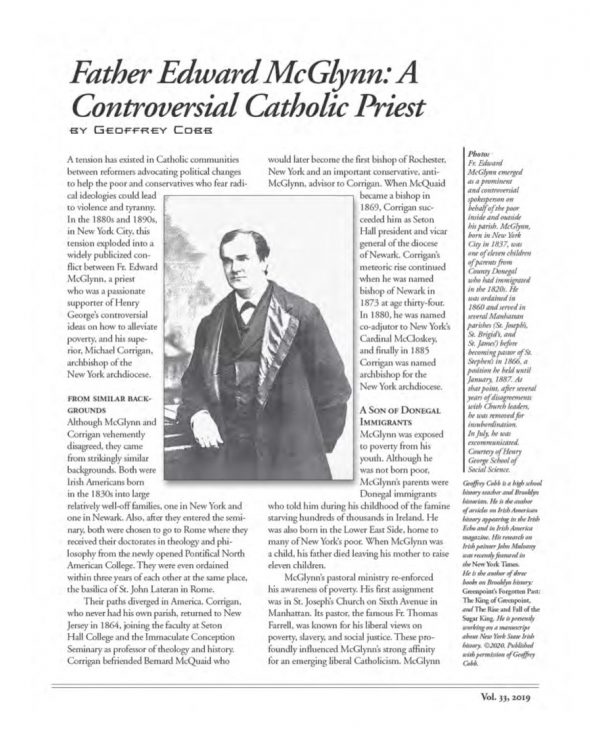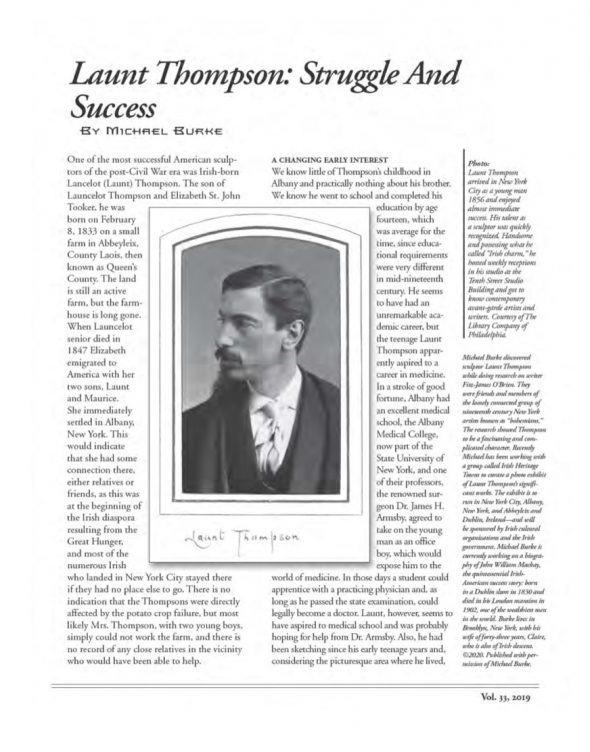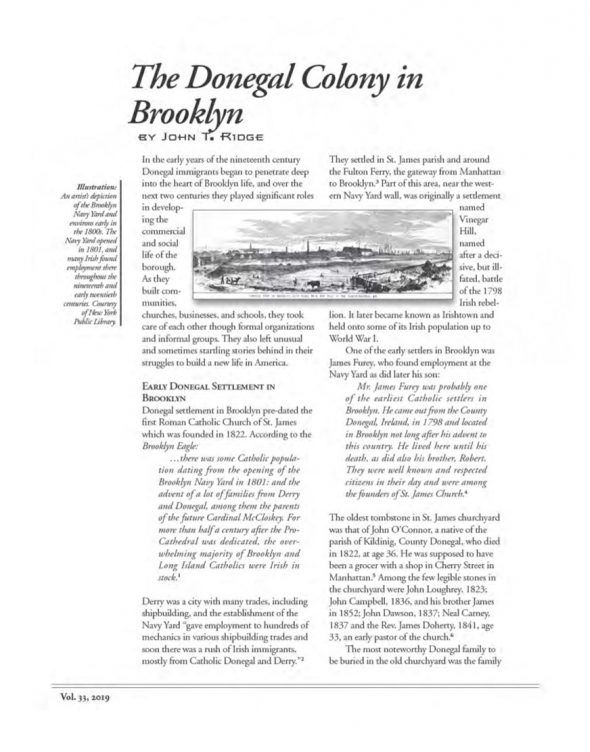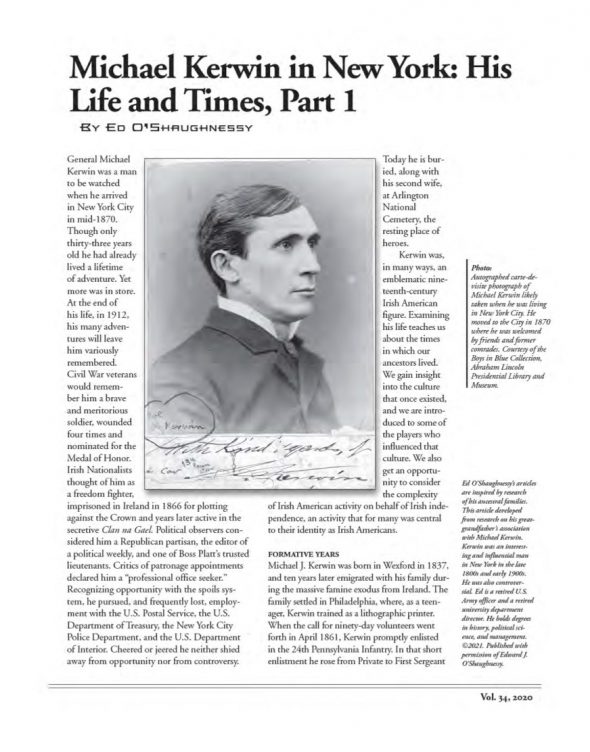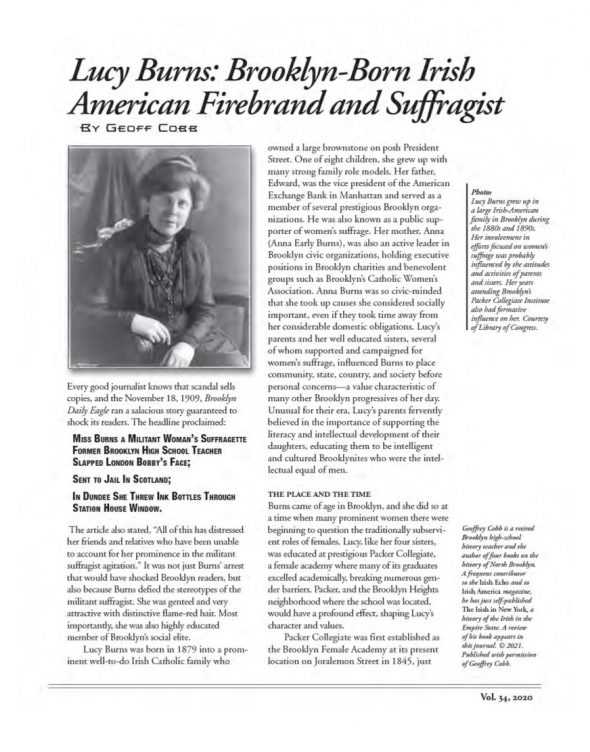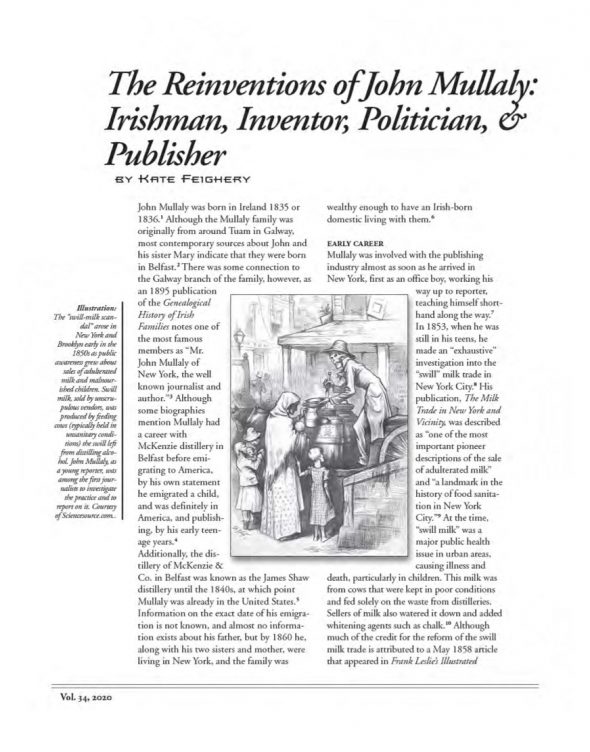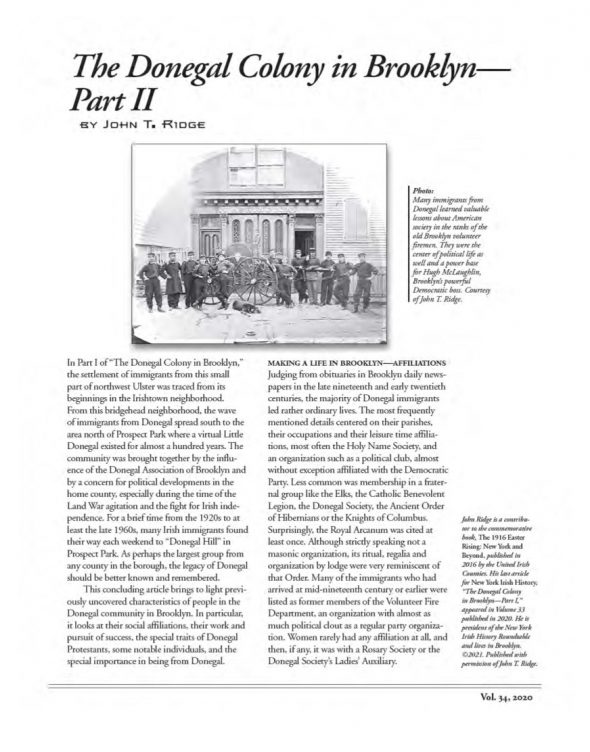New York Irish History Roundtable - Journal Articles
Father Edward McGlynn - A Controversial Catholic Priest
Author: Geoffrey Cobb
Publication Year: 2019
Journal Volume: 33
Article Reference: NYIHR-V33-03
A tension has existed in Catholic communities between reformers advocating political changes to help the poor and conservatives who fear radical ideologies could lead to violence and tyranny. In the 1880s and 1890s, in New York City, this tension exploded into a widely publicized conflict between Fr. Edward McGlynn, a priest who was passionate supporter of Henry George's controversial ideas on how to alleviate poverty, and his superior, Michael Corrigan, archbishop of the New York archdiocese.
Although McGlynn and Corrigan... [Read Full Article]
Launt Thompson - Struggle and Success
Author: Michael Burke
Publication Year: 2019
Journal Volume: 33
Article Reference: NYIHR-V33-04
One of the most successful American sculptors of the post-Civil War era was Irish-born Lancelot (Launt) Thompson. The son of Launcelot Thompson and Elizabeth St. John A CHANGING EARLY INTEREST We know little of Thompson's childhood in Albany and practically nothing about his brother.
We know he went to school and completed his education by age fourteen, which was average for the time, since educa- tional requirements were very different in mid-nineteenth century. He seems to have had an unremarkable... [Read Full Article]
The Donegal Colony in Brooklyn
Author: John T. Ridge
Publication Year: 2019
Journal Volume: 33
Article Reference: NYIHR-V33-05
An artist's depiction of the Brooklyn Navy Yard and environs early in the 1800s. The Navy Yard opened in 1801, and many Irish found employment there throughout the nineteenth and early twentieth centuries. Courtesy of New York Public Library into the heart of Brooklyn life, and over the next two centuries they played significant roles in developing the commercial and social life of the borough.
As they built com-Vol. 33, 2019 The Donegal Colony in Brooklyn BY JOHN T. RIDGE In the early years of the nineteenth century Donegal... [Read Full Article]
Michael Kerwin in New York - His Life and Times, Part I
Author: Edward J. O’Shaughnessy
Publication Year: 2020
Journal Volume: 34
Article Reference: NYIHR-V34-01
General Michael Kerwin was a man to be watched when he arrived in New York City in mid-1870. Though only thirty-three years old he had already lived a lifetime of adventure. Yet more was in store. At the end of his life, in 1912, his many adventures will leave him variously remembered. Civil War veterans would remember him a brave and meritorious soldier, wounded four times and nominated for the Medal of Honor. Irish Nationalists thought of him as otlavur Cay Today he is buried, along with his second wife, at Arlington National Cemetery,... [Read Full Article]
New Rochelle - Her Part In The Irish War Of Independence
Author: James McGlashin
Publication Year: 2020
Journal Volume: 34
Article Reference: NYIHR-V34-02
Patrick Pearse (Padraic Mac Piaras) was a Dublin school headmaster who instilled nationalism in his students. A leader of the Easter Rising, his poems and prose are seen as fundamental to twentiethcentury Irish Republicanism.
Courtesy of Library of Congress.
Vol. 34, 2020 New Rochelle: Her Part In The Irish War Of Independence BY JAMES MCGLASHIN he Easter Rising of 1916 was a military failure from the outset -with just 2,000 rebels taking over the city of Dublin on Easter Monday, April 24, they held strategic... [Read Full Article]
Lucy Burns - Brooklyn-Born Irish American Firebrand and Suffragist
Author: Geoff Cobb
Publication Year: 2020
Journal Volume: 34
Article Reference: NYIHR-V34-03
Every good journalist knows that scandal sells copies, and the November 18, 1909, Brooklyn Daily Eagle ran a salacious story guaranteed to shock its readers. The headline proclaimed: Miss BURNS A MILITANT WOMAN'S SUFFRAGETTE FORMER BROOKLYN HIGH SCHOOL TEACHER SLAPPED LONDON BOBBY'S FACE; SENT TO JAIL IN SCOTLAND; IN DUNDEE SHE THREW INK BOTTLES THROUGH STATION HOUSE WINDOW. The article also stated, "All of this has distressed her friends and relatives who have been unable to account for her prominence in the militant suffragist... [Read Full Article]
The Reinventions of John Mullaly - Irishman, Inventor, Politician, & Publisher
Author: Kate Feighery
Publication Year: 2020
Journal Volume: 34
Article Reference: NYIHR-V34-04
The "swill-milk scandal" arose in New York and Brooklyn early in the 1850s as public awareness grew about sales of adulterated milk and malnourished children. Swill milk, sold by unscrupulous vendors, was produced by feeding cows (typically held unsanitary conditions) the swill left from distilling alcohol. John Mullaly, as a young reporter, was among the first journalists to investigate the practice and to report on it. Courtesy of Sciencesource.com.
John Mullaly was born in Ireland 1835 or 1836.1 Although the Mullaly family... [Read Full Article]
The Donegal Colony in Brooklyn, Part II
Author: John T. Ridge
Publication Year: 2020
Journal Volume: 34
Article Reference: NYIHR-V34-05
In Part I of "The Donegal Colony in Brooklyn,' the settlement of immigrants from this small part of northwest Ulster was traced from its beginnings in the Irishtown neighborhood. From this bridgehead neighborhood, the wave of immigrants from Donegal spread south to the area north of Prospect Park where a virtual Little Donegal existed for almost hundred years. The community was brought together by the influence of the Donegal Association of Brooklyn and by a concern for political developments in the home county, especially during... [Read Full Article]

